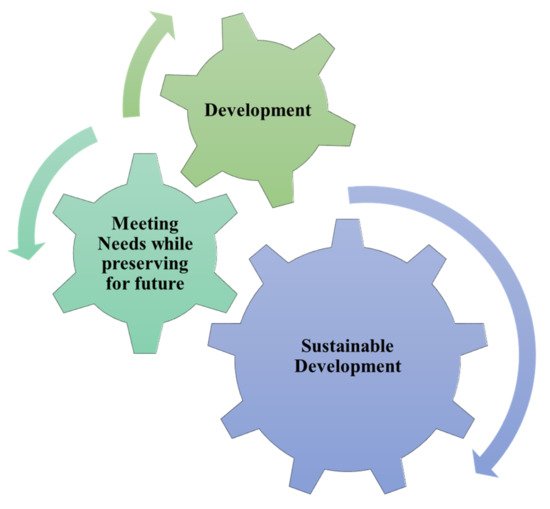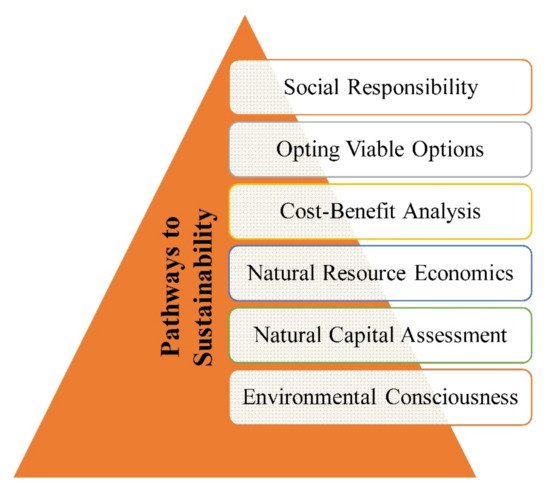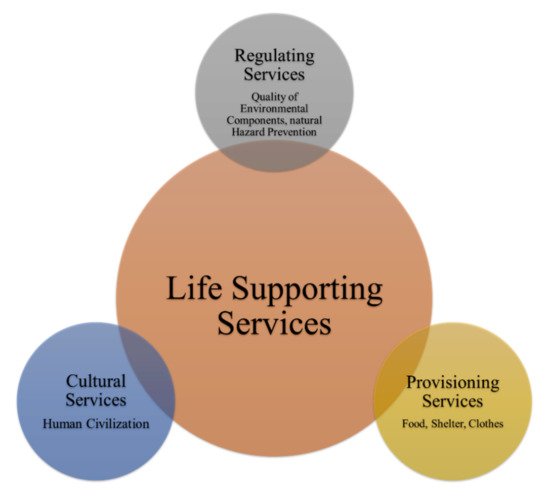Natural capital is the wealth of nations that determine their economic status. Worldwide, vulnerable people depend on natural capital for employment, salaries, wealth, and livelihoods and, in turn, this determines the developmental index of the nation to which they belong. In this short review, we have tried to sum up the ideas and discussions over natural capital’s role in ascribing economic status to countries as well as the need for natural resource management and sustainability. This paper aimed to discuss how humanity’s prosperity is intertwined with the services that ecosystems provide, and how poor natural resource management (NRM) has adversely affected human well-being. Our preselected criteria for the review paper led us to evaluate 96 peer-reviewed publications from the SCOPUS database, which is likely the most comprehensive archive of peer-reviewed scientific literature as well as WoS, PUBMED, and Google Scholar databases. Our review revealed that the availability of ecological services is crucial for clean water and air, food and fodder, and agricultural development. We further discussed important concepts regarding sustainability, natural capital and economics, and determinants of human well-being vis-à-vis the intergenerational security of natural wealth. To ensure current and future human well-being, we conclude that an in-depth understanding of the services that ecosystems provide is necessary for the holistic management of the Earth system.
1. Introduction
Natural capital is the wealth of countries that determine their economic status in the World. All the prosperous nations are wealthy based on their natural resources
[1]. Hence, each country’s income estimates are focused on the share of natural capital they possess
[2]. This makes efficient natural resources management crucial for each country. Disadvantaged populations the world over depend on natural resources for employment, wages, revenue, and livelihoods and, in turn, describe the developmental index of the country they belong to
[3].
2. Natural Resource Management (NRM)—Key to Sustainability
2.1. NRM and Natural Capital
Natural resource management (NRM) is central to every country’s policymaking and involves mitigation programs for the vulnerable and underdeveloped during disasters and crises besides the far-sighted sustainability goals
[4]. Therefore, every decision and policy concerning natural capital protection is crucial for environmental repayments to ensure long-term sustenance without becoming victims of catastrophe
[5]. Hence, NRM focuses not only on merely living but also on nurturing and providing for intellectual development, and the returns from natural resources are eventually utilized for the overall good of human civilization
[6]. The concept of sustainable development is shown in
Figure 1.
Figure 1. Concept of sustainable development
[7].
For determining the precise value of the natural capital, individual-specific indices need to be generated. Economists have established various methods of measuring the value of natural capital so that people are made aware of their costs
[8]. The two most used are existing income flows and potential income flows. Both of them operate due to manufacturing costs and demands that rely on the advantages and control of natural resources. However, there are often limitations to each method
[9].
Researchers have developed some intriguing concepts to manage natural resources sustainably. Rick van der Ploeg (2017) proposes the permanent income theory, the hotelling rule, and the Hartwick rule as significant concepts to discuss how best to manage the many components of national wealth. These concepts propose an intergenerational sovereign wealth fund, a liquidity fund to act as a precautionary buffer to deal with commodity price volatility, and an investment fund to store some of that windfall until nations are ready to absorb the extra spending on domestic investment
[10]. These planned economic set-ups are required to smooth up the natural resource consumption across human generations. Regarding the existing income flows, this approach is often misleading as it offers the value of natural capital as an inherently inaccurate overview of economic growth because of the inefficient indices that are represented as short-term progress. However, when capital is no longer accessible, development inevitably ceases
[11]. This very idea must be integrated into the nation’s public policy system that invests in the production of human capital, different portions of the riches of natural resources
[12]. Therefore, the basis for future investments is the sustainable management of all types of natural resources
[13].
Estimation or valuations of natural resources is essential to help in decision making, as already discussed in previous sections. In this context, a study carried out by Tolessa et al. (2017) in Chillimo Forest, Oromia National Regional State, Ethiopia, showed that services provided by soil such as water regulation and supply, erosion control, soil formation, nutrient cycling, food production, and habitats had shown a drastic change in economic values due to change in the land use/land cover (LU/LC) patterns over four decades
[14]. The authors argued that findings in terms of monetary values are indispensable to formulate environmental payments regulations and rural growth policies.
Both anthropogenic and natural, the LULC shift’s effect is one of the most significant drivers of change in ecosystems and their services and poses substantial threats, particularly to soil ecosystem processes and functions
[15]. After the industrial revolution, the critical drivers of LULC change worldwide have been population growth and economic expansion, especially in developing countries that prioritize economic prosperity
[16]. Seventy percent of the world’s largest cities can now be found in the developing world
[17]. In fast-growing developing countries such as India, China, Pakistan, and Turkey, the rapid urbanization and widespread LULC shift have drawn stakeholders’ challenges to devise policies that could ascertain the ecosystem’s welfare and efficiently perform natural resource management practices. Throughout the unprecedented transformation from a predominantly agricultural society to a modernized and industrialized society, vast areas of arable land, forests, grasslands, and numerous bodies of water have inevitably been used in new ways to meet the high demands of urbanization and industrial growth, ultimately affecting the services provided by the fundamental component of the biosphere, the soil
[18][19]. NRM is the solution that needs to be incorporated at all levels of policymaking, from local to global.
Figure 2 shows ways of successful implementation of the concept of sustainability.
Figure 2. Pillars of successful implementation of the concept of sustainability.
2.2. Humans and Eco-Service Values
Since early times, the foundation of every human civilization’s economy has been the services provided by the ecosystems
[20]. However, it has been considered and limited to the functioning of natural systems. Almost all the life-supporting functioning of the biosphere is sustained by the ecosystem, including waste storage, water, and nutrient storage, seed distribution and pollination, control of crop pests, and food and habitat supply for the organisms, in addition to the essential requirements of life such as air and water
[21][22][23][24].
The provision of ecological resources is thus needed for forest, fish and wildlife, safe water and air, and agricultural development, and hence necessitates the development and conservation of environmental goods, which otherwise are regarded merely as natural resources (
Figure 3)
[25]. Unless humans notice the decline in habitats, biodiversity degradation, and deserts, environmental resources are not valued, and their understanding of the economic effect of depleted environments must be assessed
[26]. Ecosystem facilities also deliver leisure and cultural events, including aesthetic enjoyment, teaching, and science study
[27].
Figure 3. Services ecosystems provide for sustaining life on Earth
[25].
De Groot et al. (2012) gave an overview of 10 principal biomes’ values based on accounting units for ecological systems
[28]. In total, 320 publications were screened, covering over 300 case study locations. About 1350 estimates of the value were coded and stored in a searchable Ecosystem Service Value Database (ESVD). For the analysis, a selection of 665 qualitative descriptions was used. The study showed that the total value of ecosystem services is considerable and ranges up to trillions of dollars per year for the pack of ecosystem services that could potentially be provided by an ‘average’ hectare of open oceans
[28].
Furthermore, in another report, Costanza and colleagues measured the annual value of ecological services worldwide at around twenty billion dollars. UNEP reports that carbon conservation by trees is worth 4 billion US dollars. Pollination by insects adds about 200 billion US dollars per year to cultivation
[29]. Furthermore, Balthazar et al. (2015)
[30], using five decades of land cover maps, tried to analyze the impact of forest cover change on the services ecosystems provide. The study had devised a new method called a multi-source convergence approach to reduce the uncertainties arising due to differences in resolutions of aerial photographs and satellite imagery. The study was carried out in the Pangor catchment, Ecuadorian Andes. They demonstrated that studies carried out at a shorter time interval might show contrasting results as their results showed net reforestation for the 1990s. However, over the 50 years, the results showed that ecosystem services provided by the soil, particularly biodiversity, soil structure, and composition, protection against water erosion, above-ground carbon storage (biomass), soil carbon storage, and aesthetic quality of the landscape, gradually fell by 16%. Moreover, globally, the conversion of grasslands into plantations has mostly had an adverse and potentially lasting effect on the distribution of ecological services provided by the soil. Furthermore, in many areas, the transformation of degraded agricultural land into pine plantations as a means of reforestation, for example, has resulted in a shift in ecological conditions destroying the biodiversity and functioning of the natural landscape.
2.3. Natural Resources-Based Capital and Employment
Natural resources are typically the backbone of local livelihoods in low- and middle-income countries and can be used to encourage investment that enhances the most underprivileged sections of the community by continually monitoring proactive policies and regulations (
Figure 4)
[31]. In poorer countries, natural capital is the primary source of employment, and leaders also prefer to encourage their optimism as incentives
[32].
Figure 4. Human well-being is a determinant of the stocks of natural resources.
Administrators emphasize their actions on the conditions for unemployment and the need to boost the GDP in all situations
[33]. Jobs are created as governments agree that vast numbers of small farmers should be given production privileges. The obligation to achieve sustainable returns from reducing big firms is optional when GDP is rising
[28]. Many researchers have shown that economic stability enhances individual well-being in a country by providing a safety net of protection against negative income shocks, permitting current and future spending flows
[34]. The fisheries industry is a persuasive example of this practice, where the more significant yet limited number of ships is more equipped to gather fish for export, while an immense flotilla of small fishing ferries would produce a more considerable amount
[35].
Nonetheless, studies indicate that non-farm revenue from natural resources plays a significant role in maintaining rural livelihoods
[36]. Policy policies aimed at promoting small and medium-sized businesses, focused on utilizing local natural capital in many instances, will encourage the development of rural economies
[37]. A convergence of priorities development, employment, and long-term economic prosperity can be seen in the implementation of policies that position countries on the road to green growth
[38].
Natural resources may provide significant employment
[39]. While this number of employees engaged in industrialized, environmentally destructive companies has decreased substantially due to the enormous potential of mechanization and increased efficiency, job opportunities in the renewable energy sources have risen and had the potential to continue to expand over the long term
[40]. For instance, clean energy workers in Europe alone have risen from over 60,000 in the late 1990s to more than 300,000 in 2006. Sustainable energy industries created more than a million employees in the late 2000 decade. Over a decade, Sweden has had a substantial and growing conservation sector, which, according to an estimate, hired around 1.5% of the national population in 1998
[41]. According to figures, Germany employs approximately 2 million employees in sustainable sectors of employment
[42].
Green jobs are also on the rise in agriculture, with research finding that organic farms have more jobs per output and selling units than traditional farms do. Sustainable, organic farming requires smaller-scale farms and less computer reliance, thereby providing more employment
[43]. Although the opportunities for job development in forestry are more nuanced, it provides steady jobs for around 2% of the world’s population
[44]. Over the coming decades, foresting programs relevant to growing demands for wood fiber and carbon sequestration would generate new employment
[45].
2.4. Poor Natural Resource Management and Costs to Human Well Being
The worldwide cost of inadequate natural resource protection is considerable, impacting least-developed and developing countries alike
[46]. Weak management of resources includes failure to sustainably maintain sustainable resources—such as loss of surplus grains in stores of India—as well as failure to adequately spend the profits from non-renewable resource purchases and failure to obtain sufficient rent from energy contracts causing the bulk of capital to go to private companies at the expense of this, a case that is being witnessed in India right now
[47]. It is evident from these approximate estimates that it is virtually incomprehensible to fully assign total costs to the complete biosphere that supplies ecosystem services for humans to live. These estimates have also been plotted in
Figure 5.
Figure 5. Graph depicting some natural resources and their approximate economic valuations using various econometric models
[48][49][50][51][52][53][54][55][56][57][58][59][60][61][62][63][64][65][66].




